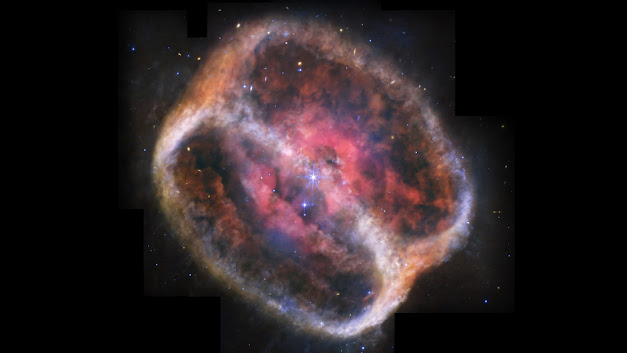In 2025, NASA’s James Webb Space Telescope (JWST) delivered yet another mesmerizing view of the cosmos this time, of the Crystal Ball Nebula, scientifically known as NGC 1514. Nestled approximately 1,500 light-years away in the constellation Taurus, this planetary nebula offers an ethereal glimpse into the final evolutionary stages of a dying star.
Thanks to JWST’s high-resolution imaging and infrared capabilities, astronomers have gained new insight into the structure, composition, and evolutionary history of this enigmatic nebula.
What is the Crystal Ball Nebula?
The Crystal Ball Nebula, NGC 1514, is a planetary nebula – a glowing shell of gas and dust ejected by a dying star in the late stages of its life. The name “planetary nebula” is somewhat misleading; these structures have nothing to do with planets. The term dates back to the 18th century, when early astronomers like William Herschel observed their round, planet-like appearance through small telescopes.
NGC 1514 stands out due to its complex, layered structure and striking symmetry, earning it the nickname “Crystal Ball.” It appears as a bright, circular region surrounded by delicate rings and filamentary gas shells – shaped over millennia by stellar winds, radiation, and interactions between binary stars.
Discovery and Historical Context
The nebula was first cataloged by William Herschel in 1790. It was a landmark discovery because Herschel noted the presence of a central star within the nebula, a revelation that helped shift scientific understanding toward the concept of planetary nebulae being stars surrounded by their own ejected material.
Historically, NGC 1514 was crucial in confirming the stellar origin of nebulae, which challenged the prevailing idea that such objects were merely unresolved star clusters or unrelated cosmic clouds.
Structure and Composition
Central Star System
At the heart of NGC 1514 lies a binary star system, composed of:
- A hot white dwarf, the remnant of the original star that ejected the nebula.
- A cooler companion star, likely responsible for shaping the surrounding material.
This binary interaction has helped sculpt the unique “bubble within a bubble” look seen in JWST’s image.
Gas and Dust Shells
JWST’s infrared imaging revealed:
- Concentric gas rings expanding outward in all directions.
- Dusty structures rich in elements like oxygen, nitrogen, and carbon.
- Complex interactions between stellar winds and ionized gases, creating layered filaments and arcs.
These features provide a real-time example of how dying stars enrich the interstellar medium with heavy elements—vital for the formation of future stars and planets.
Formation and Evolution
Stellar Evolution Pathway
The progenitor of NGC 1514 was once a sun-like star, which underwent the following stages:
- Main Sequence – Stable hydrogen fusion.
- Red Giant Phase – Outer layers expanded and became unstable.
- Planetary Nebula Phase – Outer layers were expelled via stellar winds and radiation.
- White Dwarf Remnant – The core remains, radiating energy and shaping the ejected material.
Binary Influence
Recent models suggest that the intricate, spherical symmetry of NGC 1514 is strongly influenced by the gravitational pull and angular momentum exchange between the two stars. These interactions compress gas in certain directions, forming shells, rings, and lobes—features that would be impossible to produce from a solitary star.
What Makes JWST’s Observation Unique?
While earlier telescopes like Hubble imaged NGC 1514 in visible light, JWST’s infrared capabilities allow astronomers to penetrate the dust and observe:
- Cooler materials invisible in optical wavelengths.
- Subtle temperature gradients within the gas shells.
- Chemical signatures in deeper layers of the nebula.
This has opened new doors for modeling nebular chemistry, understanding stellar feedback, and even predicting the fate of our own Sun in 5 to 7 billion years.
Scientific Significance
NGC 1514 continues to be a goldmine for astrophysicists studying:
- Stellar death processes and their contribution to the galactic ecosystem.
- Binary star interactions in late stellar evolution.
- Dust formation mechanisms in space.
- How stars recycle matter into the universe, influencing next-generation stars and planets.
Final Thoughts
The Crystal Ball Nebula is more than just a beautiful celestial object – it’s a dynamic lab in space revealing the fate of stars and the elements that make up everything we know, including us.
Thanks to JWST, we’re now able to observe and analyze the universe in ways never before possible. Each image, like the one of NGC 1514, brings us one step closer to understanding our cosmic origins and ultimate destiny.

Comments
Post a Comment